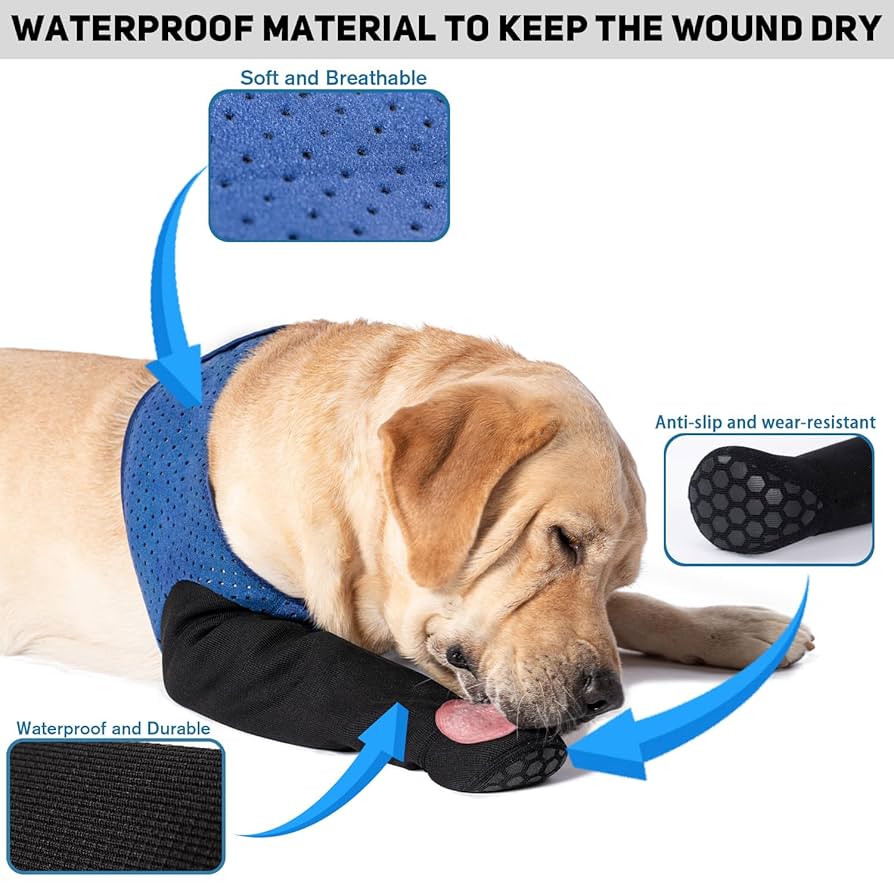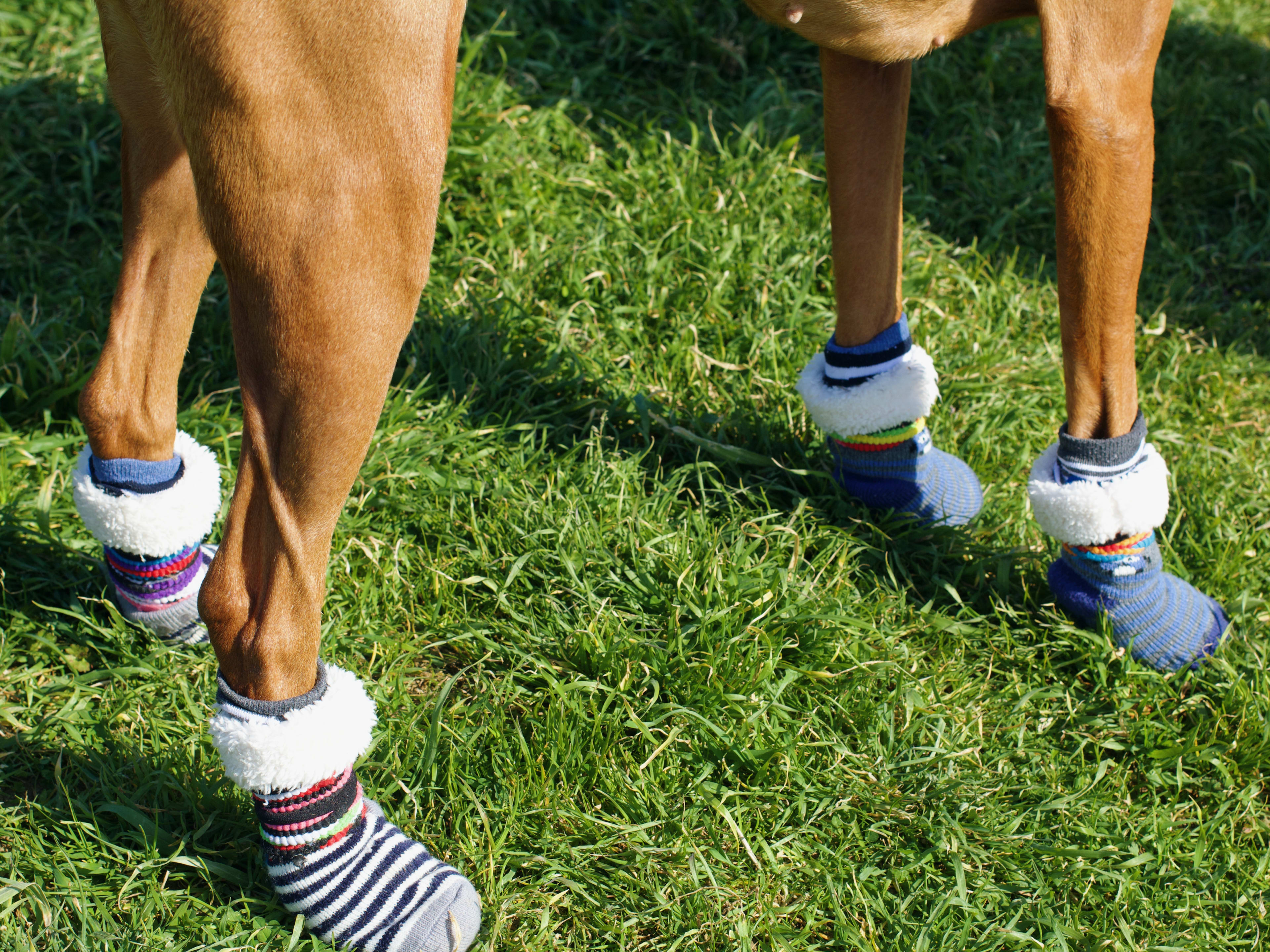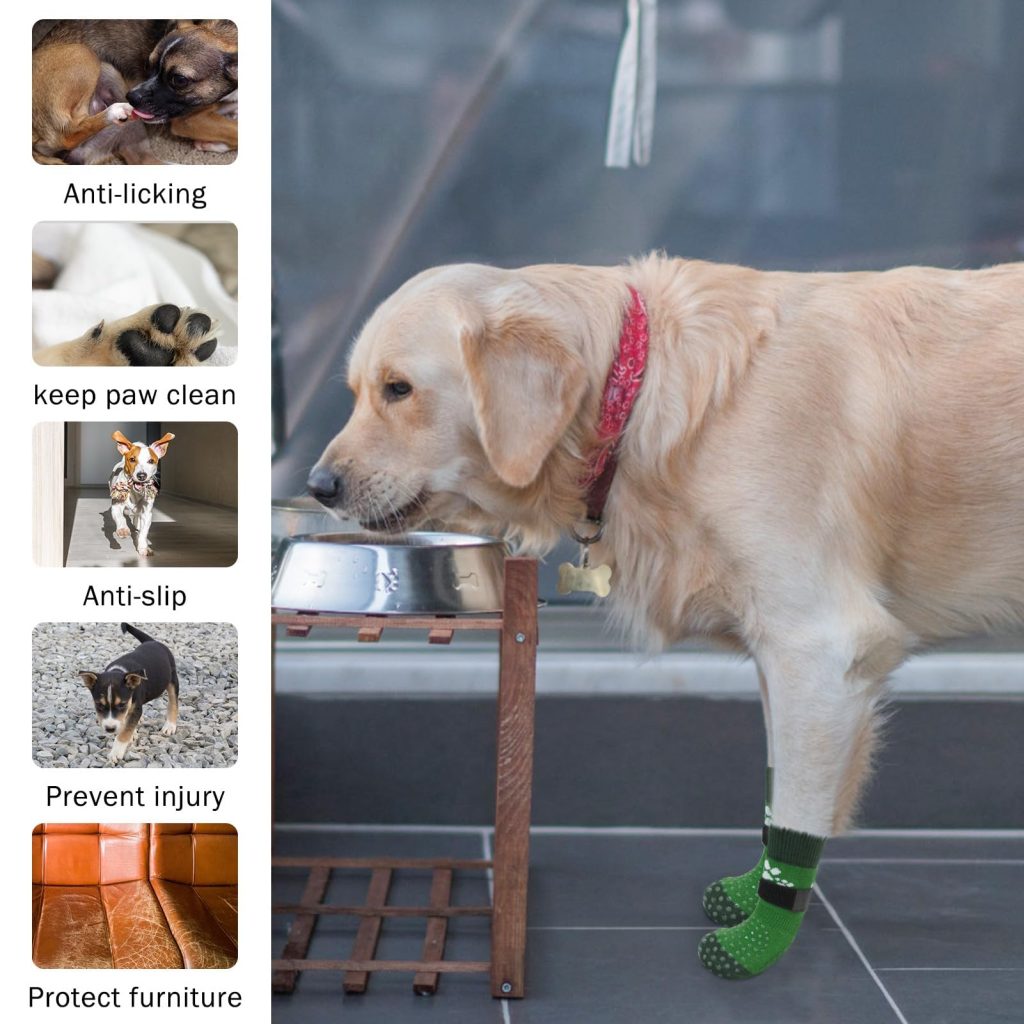Have you ever struggled to keep a sock on your dog’s paw? It can be frustrating when your furry friend keeps shaking it off or chewing it right away.
But keeping a sock on your dog is important—it protects their paws from cold floors, rough surfaces, or injuries. You’ll discover simple, effective ways to make sure that sock stays put. Stick with me, and you’ll learn tips that make life easier for both you and your dog.
Ready to solve this common problem once and for all? Let’s dive in!

Credit: www.amazon.com
Why Dogs Resist Socks
Many dogs dislike wearing socks. It feels strange on their paws. Socks can limit their natural movement. Dogs rely on their paws to explore and feel the ground. Socks block this important sense. This makes them want to remove the socks quickly.
Some dogs find socks uncomfortable. The texture or tightness bothers them. Others may not understand why they have to wear socks. This confusion can lead to resistance and fussiness. Understanding why dogs resist socks helps to keep them on longer.
Common Reasons Dogs Remove Socks
- Socks feel tight and restrict paw movement.
- The texture of socks irritates sensitive paw pads.
- Dogs feel confused or scared wearing something new.
- Socks trap heat, making paws feel too warm.
- Dogs want to clean or scratch their paws.
- They may not be used to wearing anything on their feet.
Behavioral Factors To Consider
- Dogs often remove socks to regain control.
- New experiences can cause anxiety or stress.
- Attention seeking can make dogs remove socks deliberately.
- Negative past experiences can create resistance.
- Training and patience improve acceptance over time.
- Rewarding calm behavior encourages sock wearing.
Choosing The Right Sock
Choosing the right sock for your dog can make all the difference in keeping it on comfortably and securely. Not every sock is made equal, and selecting the proper one means considering both the material and how well it fits. The right sock protects your dog’s paws without slipping off or causing discomfort, which is key for both indoor and outdoor use.
Material And Fit Matters
Look for socks made from breathable fabrics like cotton blends or soft fleece. These materials keep your dog’s paws dry and comfortable, which helps prevent irritation. Avoid stiff or rough fabrics that might cause chafing or make your dog want to remove the sock.
Fit is just as important as material. Socks should snugly hug your dog’s paws without being too tight. Too loose, and the sock will slide off quickly; too tight, and it could restrict circulation or make your dog uncomfortable.
Think about your dog’s paw size and shape. Some dogs have wider pads or longer toes, so a sock that works for one breed might not work for another. Have you ever noticed your dog chewing off socks that seem too tight or too loose? That’s a clear sign the fit isn’t right.
Features That Improve Stay
Certain design elements help socks stay on better. Look for socks with elastic bands or cuffs around the ankle. These create gentle pressure that keeps the sock from slipping off during walks or playtime.
- Non-slip grips on the sole prevent sliding on smooth floors.
- Double-stitched seams add durability and reduce the chance of the sock tearing.
- Adjustable straps or Velcro closures let you customize the fit for extra security.
In my experience, socks with rubberized grips on the bottom made a huge difference. My dog used to lose socks within minutes, but those grips kept the socks in place even during energetic fetch sessions.
Have you tried socks with these features? Notice how your dog reacts when the sock feels secure versus when it’s loose? Paying attention to these details can save you time and frustration.
Preparing Your Dog
Preparing your dog to wear a sock takes patience and care. Dogs can feel strange with new items on their paws. Taking time to help your dog adjust makes the process easier. Comfort and trust are key to success.
Getting Your Dog Comfortable
Start by letting your dog see and smell the sock. Hold it near their paws for a few moments. Let them touch it with their nose or mouth. This helps reduce fear of the unknown.
Next, try gently rubbing the sock on one paw. Do not force it. Watch your dog’s reaction and stop if they seem stressed. Repeat this step over several days to build comfort.
Use soft, stretchy socks designed for dogs. They fit better and feel less tight. Avoid socks with rough seams or tight bands that can hurt your dog.
Using Positive Reinforcement
Offer treats each time your dog allows the sock near their paw. Praise them with calm, happy words. This builds a positive link between the sock and rewards.
Give small rewards during and after the sock is on. Keep sessions short and positive. End on a good note so your dog looks forward to next time.
Be patient. Some dogs need many short sessions to adjust. Consistency helps your dog learn the sock is safe and fun.

Credit: www.amazon.com
Applying The Sock Properly
Applying a sock properly on your dog is key to keeping it secure and comfortable. A well-fitted sock protects paws from rough surfaces and cold weather without causing irritation or slipping off. The right technique makes all the difference between a sock that stays put and one that your dog quickly removes.
Step-by-step Fitting Guide
- Choose the right sock size:The sock should fit snugly around your dog’s paw without squeezing too tight. If it’s too loose, it will fall off; too tight, it will restrict circulation.
- Clean and dry the paw:Before applying the sock, make sure the paw is clean and dry to prevent slipping and irritation.
- Gently slide the sock over the paw:Hold your dog’s paw firmly but gently, then pull the sock over the toes and up the leg. Avoid forcing it, which can stress your dog.
- Adjust the sock’s position:Smooth out any wrinkles and ensure the sock covers the paw pad and ankle area comfortably.
- Secure the sock if needed:Use a soft, breathable wrap or dog bootie fastener to keep the sock from slipping off during activity.
Avoiding Common Mistakes
- Don’t choose socks that are too big or too small:Ill-fitting socks either fall off or cause discomfort and can even lead to sores.
- Avoid applying socks on dirty or wet paws:This can cause bacteria buildup, skin irritation, and make the sock slip more easily.
- Don’t ignore your dog’s comfort signs:If your dog is constantly biting or trying to remove the sock, check the fit and material for irritants.
- Avoid using socks without traction:Socks without grips can make your dog slip, especially on hardwood or tile floors.
Have you noticed your dog’s behavior change when wearing socks? Paying attention to their reactions helps you adjust the fit and material to keep them comfortable and safe.
Securing The Sock
Keeping a sock securely on your dog can be challenging, especially if your furry friend loves to shake it off. The key is to make sure the sock stays in place without causing discomfort or restricting movement. Let’s look at some practical ways to secure the sock effectively while prioritizing your dog’s safety and comfort.
Using Dog-safe Adhesives
Dog-safe adhesives are a gentle way to keep socks from slipping off. These products are designed specifically for pets, ensuring they won’t irritate your dog’s skin or fur.
You can apply a small amount of adhesive around the sock’s opening or on the inside near the ankle. This helps the sock grip better without being sticky or uncomfortable.
Have you tried pet-safe tapes or glues that are washable? They often hold well during short walks and playtime but wash off easily during bath time, making them very convenient.
Alternative Fastening Methods
If adhesives aren’t your preference, there are other ways to secure a sock on your dog. Elastic bands or soft Velcro straps can work well, especially for larger dogs with stronger legs.
- Elastic bands:Use wide, soft elastic bands to gently hold the sock in place. Avoid tight bands that might cut off circulation.
- Velcro straps:Wrap a Velcro strap just above the sock to keep it from sliding down. Make sure the strap isn’t too tight or causing irritation.
- Sewing on a small elastic cuff:Attaching an elastic cuff to the sock’s top can help it stay snug without slipping.
Have you noticed how your dog reacts to different fastening methods? Observing their comfort and movement will help you choose the best option.
Training Tips For Sock Acceptance
Getting your dog comfortable with wearing socks can be a challenge, but with patience and the right approach, you can help your furry friend accept them without fuss. Training your dog to tolerate socks involves small, consistent steps and plenty of positive reinforcement. You’ll see better results by making the experience enjoyable rather than stressful for your dog.
Building Sock Tolerance Gradually
Start by letting your dog sniff and explore the sock before trying to put it on. Hold the sock near their paws during calm moments so they associate it with something safe. Then, gently place the sock on one paw for just a few seconds and remove it right away.
Repeat this process over several days, slowly increasing the time the sock stays on. Watch your dog closely—if they show signs of distress like shaking their paw or trying to bite the sock, pause and go back a step. The goal is to build tolerance without causing frustration.
Rewarding Good Behavior
Use treats and praise immediately after your dog allows the sock to stay on. This helps your dog connect the sock with positive experiences. Try using high-value treats that your dog loves but only gets during sock training sessions.
Don’t forget to give gentle petting and encouraging words too. Rewarding even small moments of calm acceptance can motivate your dog to keep trying. Have you noticed how a simple “good job” can turn a hesitant pup into a willing participant?
When To Use Socks For Dogs
Knowing when to use socks for your dog can make a big difference in their comfort and safety. Socks aren’t just cute accessories; they serve important roles both indoors and outdoors. Understanding the right moments to put socks on your dog helps you protect their paws effectively.
Protecting Paws Indoors And Outdoors
Have you ever noticed how slippery floors make your dog struggle to walk? Socks with grips can prevent slipping on hardwood or tile floors, giving your dog better traction and confidence.
Outdoors, socks shield your dog’s paws from hot pavement in summer and cold, rough surfaces in winter. They also protect against sharp objects like glass or thorns during walks.
- Use socks on icy or salted sidewalks to avoid chemical burns.
- Put socks on when walking on gravel or rocky trails to prevent cuts.
- Consider socks if your dog spends time on surfaces that get extremely hot.
Medical And Recovery Purposes
If your dog has a paw injury or skin irritation, socks can keep the area clean and prevent licking or biting. They act as a protective barrier during healing.
After surgeries or treatments, socks help hold bandages in place and reduce the risk of infection. They also provide comfort for dogs with arthritis or sensitive paws.
- Use socks to cover wounds and keep dirt away.
- Try socks to reduce scratching caused by allergies.
- Consider socks for dogs recovering from paw surgery or injuries.
Have you ever tried using socks on your dog during recovery? You might be surprised how much they help speed up healing and keep your furry friend calm.

Credit: paradepets.com
Troubleshooting Common Issues
Keeping a sock on a dog can be tricky. Dogs often try to chew or remove the sock quickly. Some dogs may feel uncomfortable or show signs of allergies. This section helps solve these common problems. Simple tips make the process easier for both you and your pet.
Dealing With Chewing And Removal
Dogs may chew on the sock because of texture or boredom. Distract your dog with toys or treats. Use a snug but not tight sock to stay in place. Try covering the sock with a soft bootie for extra protection. Regularly check the sock for damage. Replace it if torn to avoid choking hazards.
Handling Discomfort And Allergies
Some dogs may feel itchy or irritated by the sock material. Choose socks made of soft, breathable fabric like cotton. Avoid tight socks that cut off circulation or cause swelling. Watch for redness, swelling, or excessive licking. Remove the sock immediately if any allergic reactions appear. Consult a vet if irritation continues or worsens.
Frequently Asked Questions
How Can I Keep A Sock On My Dog’s Paw?
Use a snug-fitting sock with a non-slip band. Wrap it with vet wrap to secure without cutting off circulation. Check often to ensure comfort and adjust if needed.
What Materials Help Socks Stay On Dogs Longer?
Choose socks made from stretchy, breathable fabrics like cotton or polyester. Look for socks with rubber grips or silicone pads on the bottom. These materials improve traction and reduce slipping.
When Is It Necessary To Keep A Sock On A Dog?
Socks protect injured paws, prevent licking wounds, or provide warmth in cold weather. They also help dogs with mobility issues by improving grip and stability on slippery floors.
How Do I Prevent My Dog From Removing Its Sock?
Ensure the sock fits well but isn’t too tight. Use a light adhesive or vet wrap to secure it. Distract your dog with toys or treats to reduce sock chewing or pulling.
Conclusion
Keeping a sock on your dog can be challenging but rewarding. With patience and the right techniques, success is achievable. Remember to choose the correct sock size for comfort. Secure the sock without hurting your dog’s leg. Try using a non-slip sock to prevent falls.
Make sure to monitor your dog for any discomfort. Practice makes perfect, so don’t give up easily. Your dog will adjust over time. This small step can protect paws from injuries. Happy, healthy paws make a happy dog. Keep your furry friend safe and cozy with these simple tips.

